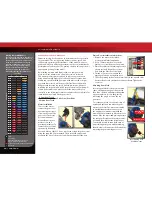
TRAXXAS • 9
THE TRAXXAS TQ RADIO SYSTEM
RADIO SYSTEM TERMINOLOGY
Please take a moment to familiarize yourself with these radio and power system
terms. They will be used throughout this manual.
BEC (Battery Eliminator Circuit)
- The BEC can either be in the receiver or
in the ESC. This circuit allows the receiver and servos to be powered by
the main battery pack in an electric model. This eliminates the need to
carry a separate pack of 4 AA batteries to power the radio equipment.
Channel
- The 27 MHz
frequency band is
divided into 6 channels
so that up to six models
can be operated
simultaneously. Each
channel is referred to
by its flag color and
channel number, as
shown on the chart to the right.
Clearing your frequency
- A routine, verbal check to make sure nobody
else in your area is operating on the same channel. Always clear your
frequency by calling out your channel number before operating your
model. Wait or move to another area if your channel is already being
used.
Crystal (X-tal)
- The plug-in device that determines which channel the
radio system will operate on. For each channel, there are two crystals,
one for the receiver and one for the transmitter. Of those two crystals,
the one marked with the lower number (.455 MHz lower) must be
inserted into the receiver.
Current
- Current is a measure of power flow through the electronics,
usually measured in amps. If you look at wire like a garden hose, current
is a measure of how much water is flowing through the hose.
ESC (Electronic Speed Control)
- An electronic speed control is the
electronic motor control inside the model. Electronic speed controls
use power more efficiently than mechanical speed controls so that the
battery runs longer. An electronic speed control also has circuitry that
prevents loss of steering and throttle control as the battery loses its
charge.
Frequency band
- The radio frequency used by the transmitter to send
signals to your model. All Traxxas RTR models operate on a 27 MHz
frequency band.
kV Rating
- Brushless motors are often rated by their kV number.
The kV rating equals no-load motor rpm with 1 volt applied.
The kV increases as the number of wire turns in the motor decreases. As
the kV increases, the current draw through the electronics also increases.
mAh
– Abbreviation for milliamp hour. A measure of the capacity of the
battery pack. The higher the number, the longer the battery will last
between recharges.
Neutral position
- The standing position that the servos seek when the
transmitter controls are at the neutral setting.
NiCad
- Abbreviation for nickel-cadmium. The original rechargeable hobby
pack, NiCad batteries have very high current handling, high capacity,
and can last up to 1000 charging cycles. Good charging procedures are
required to reduce the possibility of developing a “memory” effect and
shortened run times.
NiMH
- Abbreviation for nickel-metal hydride. Rechargeable NiMH
batteries offer high current handling, and much greater resistance to the
“memory” effect. NiMH batteries generally allow higher capacity than
NiCad batteries. They can last up to 500 charge cycles. A peak charger
designed for NiMH batteries is required for optimal performance.
Receiver
- The radio unit inside your model that receives signals from the
transmitter and relays them to the servos.
Resistance
- In an electrical sense, resistance is a measure of how an
object resists or obstructs the flow of current through it. When flow
is constricted, energy is converted to heat and is lost. Traxxas power
systems are optimized to reduce electrical resistance and the resulting
power-robbing heat.
Servo
- Small motor unit in your model that operates the
steering mechanism.
Transmitter
- The hand-held radio unit that sends throttle and steering
instructions to your model.
Trim
- The fine-tuning adjustment of the neutral position of the servos,
made by adjusting the throttle and steering trim sliders on the face of
the transmitter.
Thermal Shutdown Protection
- Temperature sensing electronics used
in the electronic speed control detect overloading and overheating of
the transistor circuitry. If excessive temperature is detected, the unit
automatically shuts down to prevent damage to the electronics.
2-channel radio system
- The TQ radio system, consisting of
the receiver, the transmitter, and the servos. The system uses two
channels: one to operate the throttle and one to operate
the steering.
Voltage
- Voltage is a measure of the electrical potential
difference between two points, such as between the positive battery
terminal and ground. Using the analogy of the garden hose, while
current is the quantity of water flow in the hose, voltage corresponds to
the pressure that is forcing the water through the hose.










































